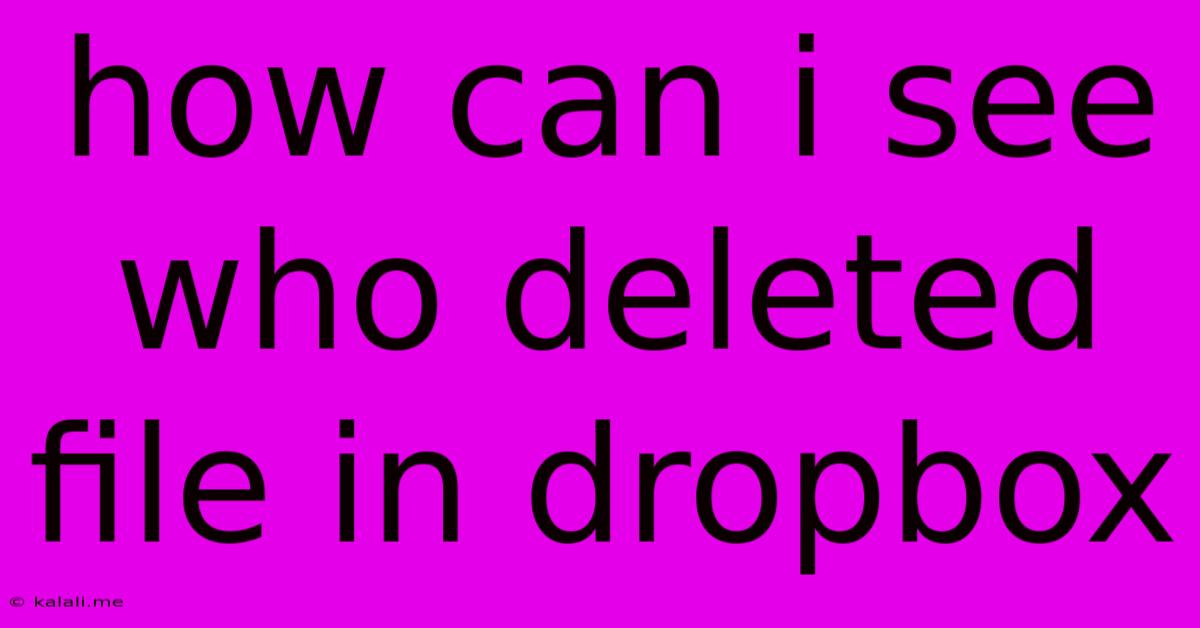How Can I See Who Deleted File In Dropbox
Kalali
May 30, 2025 · 3 min read

Table of Contents
How Can I See Who Deleted a File in Dropbox?
Dropbox doesn't offer a built-in feature to directly show you who deleted a specific file. Unlike some other collaborative platforms with extensive audit trails, Dropbox's focus is on file synchronization and sharing, not detailed activity logging for every single deletion. This lack of a dedicated "who deleted what" log can be frustrating, especially in shared workspaces. However, there are several ways you can try to find out who might be responsible, depending on your Dropbox setup and the context of the deletion.
Understanding Dropbox's Limitations
Before we delve into potential solutions, it's crucial to acknowledge that Dropbox's design prioritizes ease of use and syncing. A comprehensive audit trail for every file action would significantly increase server load and complexity. Therefore, directly identifying the deleter is often impossible without supplementary measures.
Methods to Investigate File Deletion
While you can't pinpoint the culprit directly within Dropbox, these methods can offer clues:
1. Check Dropbox's Version History (If Enabled):
-
The Power of Versions: If version history is enabled for the folder containing the deleted file (this is a setting you can adjust within Dropbox), you might be able to recover the file. More importantly, the version history might show the last person who modified the file before its deletion. This isn't a guarantee, but it's a good starting point. Note that this only works if the file was modified before deletion; a simple delete without prior modification won't leave a trace in the version history.
-
Limitations: This only provides indirect evidence and doesn't explicitly name the deleter. It also depends on whether version history was activated and the retention period set for your plan.
2. Review Shared Folder Activity (For Shared Folders):
-
Collaboration Insights: If the file resided in a shared folder, check the activity feed or any event logs your team might have access to. Some teams utilize third-party collaboration tools integrated with Dropbox, which may offer more detailed logs.
-
Investigative Approach: This requires careful examination of the activity timeline around the deletion, looking for any suspicious behavior or activity from specific users. Again, this is indirect evidence and requires careful analysis.
3. Leverage Dropbox Paper or Other Collaboration Tools:
-
External Evidence: If the file was discussed or referenced within Dropbox Paper or a similar collaboration tool, the conversation history might provide clues as to who was interacting with the file last.
-
Cross-Referencing Data: Combine this with other methods to build a clearer picture of the file's lifecycle and potential reasons for its deletion.
4. Communicate with Your Team:
-
Direct Inquiry: In many situations, the simplest solution is to ask your team members directly. Explain the situation, emphasizing the importance of recovering the file and understanding what happened.
-
Importance of Transparency: This approach fosters a collaborative environment and often leads to a quick resolution.
5. Utilize Third-Party Monitoring Tools (Consider the Implications):
-
Advanced Logging: There are third-party tools that can provide more granular logging for file activities within Dropbox. However, this involves granting access to these tools, raising security considerations, and potentially impacting the performance of your Dropbox account.
-
Privacy vs. Accountability: Carefully weigh the benefits against the potential risks before implementing such solutions.
Prevention is Better Than Cure:
The most effective approach is to prevent these situations from occurring in the first place. Consider:
- Regular Backups: Implement a robust backup strategy, regardless of your reliance on Dropbox. This ensures that even if files are accidentally deleted, you have a copy readily available.
- Version History Enablement: Always enable version history for important folders.
- Clear Communication Protocols: Establish clear guidelines and communication protocols for your team regarding file management and deletion within shared folders.
While Dropbox doesn't natively track who deleted a file, a combination of these methods can often lead to an understanding of what happened and, in some cases, help recover the lost data. Remember to prioritize communication and implement preventive measures to reduce the chances of future accidental deletions.
Latest Posts
Latest Posts
-
Different Fairy Types In Fairly Odd Parents
May 31, 2025
-
How To Minus Front From Multiple Lines In Illustrator
May 31, 2025
-
How To Get Decals Off Car
May 31, 2025
-
How Do You Say What Is This In French
May 31, 2025
-
How Do You Juice A Lemon Without A Juicer
May 31, 2025
Related Post
Thank you for visiting our website which covers about How Can I See Who Deleted File In Dropbox . We hope the information provided has been useful to you. Feel free to contact us if you have any questions or need further assistance. See you next time and don't miss to bookmark.